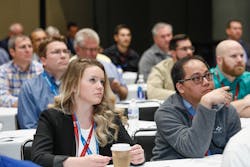Editor's Note: The Power (& Virtue) of Associations
In this dog-eat-dog, competitive free-for-all in which we live and work, it is surprisingly easy to lose sight of the whole. Many among us believe that the profit motive is king and that the best way to advance any market is to strip it of regulation and just get out of its way. In other words, just let Nature take its course.
Well, there is certainly more than a little bit of validity to that view. And free market capitalism, itself, seems to push us to never trust our competitors, much less work with them on any supposedly common goals. But engineers know better.
They are problem solvers. And if more expertise is needed to answer vexing questions, engineers are often more than happy to go find help.
In fact, isn’t that a big part of the reason why professional associations even exist in our industry? I was reminded of this last month in Atlanta while attending the annual AHR Expo and ASHRAE Winter Conference. It is a fabulous showcase for new products, to be sure, but it is also a vital opportunity for attendees to learn the latest news and best practices from peers who are working together to raise the bar for all.
Technology, for example, may bill itself as a difference-maker. But in practicality, it must still be able to operate within other systems if it is to be effective. For instance, take BACnet International, the industry association that facilitates the successful use of the BACnet protocol in building automation and control systems through interoperability testing, educational programs and promotional activities. It was developed by ASHRAE and has been made publicly available so that manufacturers can create interoperable systems of products.
“Our goal is to find what works for everyone, from small single-family homes to large universities,” said Edward Tom, a product manager for Yaskawa, who presented a talk on BACnet 101 in Atlanta. “If we leave it all up to the manufacturers, it will become the Wild West.”
What works for everyone…
Similarly, Johnson Controls (JCI) announced at AHR that it had entered into an agreement with CBRE, World Resources Institute (WRI) and Lawrence Berkeley National Laboratory to test and deploy an open-source, web-based energy analysis tool to identify energy-efficient retrofit opportunities in commercial buildings. The initiative is part of the JCI and CBRE Innovation Lab, which was established three years ago to evaluate, connect and leverage products, services and energy data to create value for occupiers and investors of real estate.
JCI developed the LEAN energy analysis technology over the past eight years and has used the tool to analyze retrofit opportunities in over 700 buildings. The Berkeley Lab is working with JCI to automate and improve the technology and create an open-source version of the tool for public use.
Open source, public use
Leaf through this issue—or any issue—of HPAC Engineering, and the influence of the collective in our industry is apparent. The Mechanical Contractors Association of America (MCAA), Construction Financial Management Association (CFMA), and National Electrical Contractors Association (NECA) all are co-sponsors of the new JBKnowledge Construction Technology Survey, summarized here.
Last issue featured our regular special section from the American Boiler Manufacturers Association (ABMA) and our next issue will offer more insights from the Air Movement and Control Association (AMCA), which anchors our ‘Association Solutions’ column. The simple rationale is that two heads are better than one, and the more the merrier, when it comes to problem-solving.
Many of us may still like to think of ourselves as rugged individualists or even cowboys or pioneer women. But at the end of the day, we are all in this together, trying to find a better way to do our jobs and to serve our customers. And luckily, associations are here to help.
About the Author
Rob McManamy
Editor in Chief
An industry reporter and editor since 1987, McManamy joined HPAC Engineering in September 2017, after three years with BuiltWorlds.com, a Chicago-based media startup focused on tech innovation in the built environment. He has been covering design and construction issues for more than 30 years, having started at Engineering News-Record (ENR) in New York, before becoming its Midwest Bureau Chief in 1990. In 1998, McManamy was named Editor-in-Chief of Design-Build magazine, where he served for four years. He subsequently worked as an editor and freelance writer for Building Design + Construction and Public Works magazines.
A native of Bronx, NY, he is a graduate of both the University of Virginia, and The John Marshall Law School in Chicago.
Contact him at [email protected].
